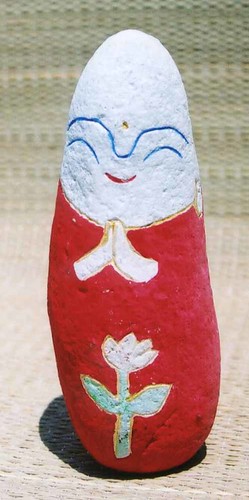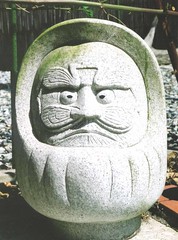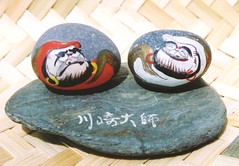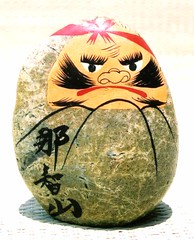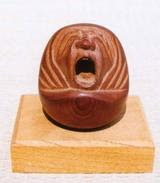[ . BACK to DARUMA MUSEUM TOP . ]
for temple Denbo-In, see below
:::::::::::::::::::::::::::::::::::::::::::::::::::::::::::::::::::::::::::::::::::::::::::::::::::::
Puns, dajare 駄洒落 ダジャレ, だじゃれ
paronomasia
Puns, share-kotoba しゃれ言葉, were very popular in Old Edo.
Dajare is also called "local dialect"
jiguchi 地口.
In Old Edo, many people from all parts of Japan lived side by side.
Puns and playw with words were often used when people met for the first time to break the ice, so to speak, and make them feel comfortable. A person who could not tell a good pun was thought of rater dull (yabo やぼ 野暮), a country bumpkin.
yabo is itself a deformation of the word 「野夫」 a worker from the countryside.
hara ga herima daikon 腹が減りま大根
(練馬大根とかかっている)
ari ga too nara imo mushi hatachi
ありが十(とお)なら いもむし二十(はたち)
蟻が十なら、芋虫ゃ二十 > ありがとうなら、いもむしはたち
kon te wa kuwana no yaki-hamaguri
その手は桑名の焼きはまぐり >
「その手は桑名い」 > 「その手は食わない」
osore iriya no kishibojin
「恐れ入谷の鬼子母神」 > 「恐れ入りました」 > 「恐れいりやした」
Kishibojin is the deity of a famous temple in Iriya.
http://www.atomlt.com/07people/people01_01.html
atari maeda no kurakka
「当たり前田のクラッカー」
umakatta
「馬勝った~牛負けた」 >
「ごちそーさま。うまかった~」
sore wa zannen binshiken
「それは残念、閔子騫(びんしけん)」
顔淵・閔子騫(がんえん・びんしけん)
Ganen was a famous student of Confucius and well known at the temple schools of Edo.
Ganen > zannen
Here is a LINK with a lot more in Japanese
語呂合わせ goro awase
http://homepage3.nifty.com/downtown-boy/jisyo/jisyo1.html
:::::::::::::::::::::::::::::::::::::::::::::::::::::::::::::::::::::::::::::::::::::::::::::::::::::
jiguchi andon 地口行灯 lanterns with puns and paintings
People painted a pun with image and words on a lantern for the annual festival of Chingo-Do 鎮護堂 in Asakusa, usually called おたぬきさん Otanuki-San at the temple 伝法院
Denbo-In


Denboin doori 伝法院通り
Denboin-dori, Road along Denbo-In
Denpo-In
famous for this custom to our day ! About 200 meters with the atmosphere of "Old Edo".
Denbo-In also has a famous garden.
- reference : denbouin-dori.com/midokoro-
- quote -
Denbo-in Teien Garden 伝法院庭園
Walking on Nakamise Street to Hozo-mon Gate and crossing Denbo-in-dori Street, you can find a solemn front gate at the secluded place from the left. Going through the front gate, you arrive at Denbo-in Temple which is the office of Senso-ji Temple and also the residence for head priest for generations. The garden covering the greater part of Denbo-in Temple is separated from the bustle of tourists, and a calm air is blowing among the garden. Here is one of the few temple gardens from the Edo period in Tokyo.
This garden is estimated to be originally landscaped in the Middle Ages. Old drawings and the style of landscape show that the present allocation of space arranging ponds on the north and west side of buildings is unchanged from the early Edo period.
Looking at the west pond from Ojoin (large drawing room) facing the garden, you see a large artificial hill on the left, the stone arrangement which represents a three-step dry fall from the top of the hill and the sandy beach which represents the water surface. Turning your eyes to the center, an undulating shore in islands spreads out.
Strolling around the pond and standing on the island on the opposite side of Ojoin, you can see a full view of the fivestoried pagoda through the sandy beach arranging stepping-stones and Ojoin. Viewing the north shore which is gently undulating in contrast to the west, it is better to see standing on the stone bridge across a stream joining each pond.
Denbo-in Teien was a secret garden as even the daimyo were not easily allowed to visit, because Denbo-in Temple was used as Gozen-sho (the place Tokugawa shoguns took a meal or rest) when they came. However, when the precinct of Senso-ji Temple was designated as a public park in 1873, this garden had been open to the public by Tokyo from 1930 to the outbreak of the Pacific War. At present, here is open to the public for a certaion period by Senso-ji Temple. This garden hands down the atmosphere of the Edo period to now, which was mostly lost from Asakusa in the Great Kanto Earthquakes and the Pacific War.
- source : syougai.metro.tokyo.... -
.......................................................................


 source : kakinokidai.web.fc2.com/JiguchiAndon
source : kakinokidai.web.fc2.com/JiguchiAndon
:::::::::::::::::::::::::::::::::::::::::::::::::::::::::::::::::::::::::::::::::::::::::::::::::::::
目出だるま me ga deru
to have good luck
The eyes of a dice, wishing for a SIX to win in gambling.

乗蓮寺 Temple Jooren-Ji
目が出る、が転じて
芽が出る、にかけているだるま。
駄洒落!? と思ってしまう授与品が多いのも、神社めぐりの楽しみのひとつ。
More items for good luck on this LINK
http://www.appleway.co.jp/apple/200501/feature/06.html
:::::::::::::::::::::::::::::::::::::::::::::::::::::::::::::::::::::::::::::::::::::::::::::::::::::
dajare e-uta 駄洒落絵歌 Pun with Song and Picture
Da da Daruma no ningyoo wa
shaberitakute mo shaberenai
黙々だるま の 人形は
しゃべりたくとも しゃべれない
ぎょろり目玉で 世の中を
怒った顔して にらんでる
Copyright (C) 2004 Sora Eizo
Look at the Daruma on this LINK to see him develop as you read the full poem.
http://www.geocities.jp/sora_eizo/dajareuta/029_mokumoku/index.html
ANIME only
http://pro.tok2.com/~miyuki-h/expression/j/gallery/free/free9/sora-9.GIF
:::::::::::::::::::::::::::::::::::::::::::::::::::::::::::::::::::::::::::::::::::::::::::::::::::::
昨夜、博多市内の居酒屋で酒に酔った女性が暴れだし、店内のだるまを壊すなどしたため駆けつけた警察官に取り押さえられました。調べによると、この女性はpinpin(24)で「駄洒落が思いつかず、
だるまに笑われているような気がした。むしゃくしゃしてやった」などと供述している模様です・・・
だ、だるま!だるまさんと口論だ!のニュースだな。
http://ke-shi.blogzine.jp/polan/2004/10/post_19.html
:::::::::::::::::::::::::::::::::::::::::::::::::::::::::::::::::::::::::::::::::::::::::::::::::::::
Here is a bit more on the ants ARI GA 蟻が play with words.
This is all a word joke on ARIGATOO, thank you.
3月9日は「サンキューの日」 Sankyuu の日 > Thank You !
「蟻が十匹猿五匹」 > (ありがとうござる)
「蟻が鯛なら芋虫ゃ鯨、百足汽車なら蝿が鳥」(信州) > (ありがたい)
「蟻が十なら芋虫ゃ二十」(信濃童詞)
「蟻が十なら蚯蚓が二十、蛇が二十五で嫁に行く」(東京)
http://kotobakai.seesaa.net/article/8180103.html
.............................A Set of Contrasts
puns with the words
katta and
maketa
one is winning, one is loosing
kowakatta - oya maketa
恐かった~ : 子は勝った 親負けた
kayukatta - meshi maketa
痒かった : 粥勝った 飯負けた
takakatta - tonbi maketa
高かった : 鷹勝った とんび負けた
amakatta - boozu maketa
甘かった : 尼勝った 坊主負けた
fukakatta - same maketa (fuka and same are names for the shark)
深かった : 鱶勝った 鮫負けた
http://www.mmjp.or.jp/m_satoh/_Essay_1.html
:::::::::::::::::::::::::::::::::::::::::::::::::::::::::::::::::::::::::::::::::::::::::::::::::::::
kono ikura wa ikura このイクラはいくら How much costs this salmon roe?
konya kuu no wa konnyaku 今夜食うのは蒟蒻
tonight I am going to eat Konnyaku (devil's tongue jelly)
shio ga nai no wa shoo ga nai 塩がないのはしょうがない
It can’t be helped if there is no salt available.
sukii ga suki スキーが好き I like skiing
:::::::::::::::::::::::::::::::::::::::::::::::::::::::::::::::::::::::::::::::::::::::::::::::::::::
In our modern times, there is even English involved in the
oyaji gyagu おやじギャグ gags of elderly men
imakita sangyoo 今北産業 "now North Industry" -
ima kita 今来た I just joined, just came
san gyoo 三行 three lines, entering into an online conversation
Modern Pun-Ordering at the Sushi bar:
gareeji ガレージ
garage - shako 車庫 - shako 蝦蛄 Shako shrimp
reinkooto レインコート
raincoat - kappa 合羽 - kappamaki かっぱ巻き
:::::::::::::::::::::::::::::::::::::::::::::::::::::::::::::::::::::::::::::::::::::::::::::::::::::
Tokyo is situated in the
Musashi plain 武蔵平野
MU SA SHI 。。。六三四 - 6 3 4
So when the tower had to be just a bit higher than the tower in China, they decided to make it
634 meters high.
. Tokyo Sky Tree 東京スカイツリー Skytree .
:::::::::::::::::::::::::::::::::::::::::::::::::::::::::::::::::::::::::::::::::::::::::::::::::::::
Puzzle pictures, Rebus of Old Edo, hanji-e 判じ絵
:::::::::::::::::::::::::::::::::::::::::::::::::::::::::::::::::::::::::::::::::::::::::::::::::::::
[ . BACK to WORLDKIGO . TOP . ]
[ . BACK to DARUMA MUSEUM TOP . ]
:::::::::::::::::::::::::::::::::::::::::::::::::::::::::::::::::::::::::::::::::::::::::::::::::::::






























